René-Robert Cavelier, Sieur de La Salle
René-Robert Cavelier | |
|---|---|
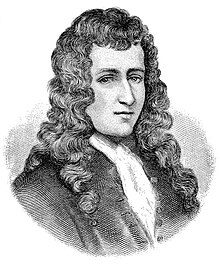 A 19th-century engraving of Cavelier de La Salle | |
| Born | November 22, 1643 |
| Died | March 19, 1687(aged 43) present-dayHuntsville,Texas |
| Nationality | French |
| Occupation | explorer |
| Known for | exploring theGreat Lakes, Mississippi River, and theGulf of Mexico |
| Signature | |
René-Robert Cavelier, Sieur de La Salle(/ləˈsæl/;November 22, 1643 – March 19, 1687), was a 17th-century French explorer andfur traderin North America. He explored theGreat Lakesregion of theUnited StatesandCanada,and theMississippi River.He is best known for an early 1682 expedition in which he canoed the lower Mississippi River from the mouth of theIllinois Riverto theGulf of Mexico;there, on 9 April 1682, he claimed the Mississippi River basin for France after giving it the nameLa Louisiane.One source states that "he acquired for France the most fertile half of the North American continent".[1][2]A later ill-fated expedition to the Gulf coast of Mexico (today the U.S. state of Texas) gave the United States a claim to Texas in the purchase of the Louisiana Territory from France in 1803. La Salle was assassinated in 1687 during that expedition.
AlthoughJolietandMarquettepreceded him on the upper Mississippi in their journey of 1673–74, La Salle extended exploration, and France's claims, all the way to the river's mouth, while the existing historical evidence does not indicate that La Salle ever reached theOhio/Allegheny Valley.
Early life

Robert Cavelier was born on November 22, 1643, into a comfortably well-off family inRouen,France, in the parish Saint-Herbland.[3]His parents were Jean Cavelier and Catherine Geest.[4]His older brother, Jean Cavelier, became aSulpicianpriest. When Robert was young, he enjoyed science and nature. In his teens, he studied with theJesuitreligious order and became a member after taking initial vows in 1660.[a]
Required toreject his father's legacywhen he joined the Jesuits, La Salle was nearly destitute when he traveled as a prospective colonist to North America. He sailed forNew Francein the spring of 1666.[6]His brother Jean, had moved there the year before. At La Salle's request on March 27, 1667, after he was in Canada, he was released from the Society of Jesus after citing "moral weaknesses".[4]
La Salle was granted aseigneurieon land at the western end of theIsland of Montreal,which became known asLachine.[7][b]La Salle immediately began to issue land grants, set up a village and learn the languages of the Native people, several tribes of Iroquois in this area.[9]
Sieur de La Salle
Sieur de La Salleis a French title roughly translating to "Lord of the manor".[10] Sieuris a French title of nobility, similar to the English "Sir," but under the French seigneurial system, the title is purchased rather than earned, and does not imply military duty. Robert Cavelier took the title with his seigneurial purchase ofLachinefrom the Sulpician order at Ville Marie around 1667. It refers to the name of a family estate near Rouen.[11]However, the phraseLa Sallehas become iconic, and associated with the person as if it were his name; he is therefore often called Robert La Salle, or simply "La Salle".
Expeditions
This section mayrequirecleanupto meet Wikipedia'squality standards.The specific problem is:The sources for the footnotes and other information in this section are unclear.(April 2019) |
"Ohio" expedition
The Seneca told La Salle of a great river, called theOhio,[c]which flowed into the sea, the "Vermilion Sea".[d]He began to plan for expeditions to find a western passage to China. He sought and received permission from GovernorDaniel CourcelleandIntendantJean Talonto embark on the enterprise. He sold his interests in Lachine to finance the venture.[14]
La Salle left Lachine by the St. Lawrence on July 6, 1669, with a flotilla of nine canoes and 24 men, an unknown number of Seneca guides: himself and 14 hired men in four canoes, the two Sulpicians Dollier de Casson and Abbé René de Bréhan de Galinée with seven new recruits in three canoes, and two canoes of Natives. Having travelled up the St. Lawrence and across Lake Ontario for 35 days, they arrived at what is called todayIrondequoit Bayon the southern shore of Lake Ontario at the mouth of Irondequoit Creek, a place now commemorated as La Salle's Landing.
There they were greeted by a party of Natives, who escorted them starting the next day to a village some leagues distant, a journey of a few days. At the village, the Seneca vehemently attempted to dissuade the party from proceeding into the lands of their enemies, theAlgonquins,telling of the dire fate awaiting them. The necessity of securing guides for the further part of the journey, and the refusal of the Seneca to provide them, delayed the expedition a month. A fortuitous capture by the Natives in the lands to the south of a Dutchman who spokeIroquoiswell but French poorly, and was to be burned at the stake for transgressions unknown, provided an opportunity to obtain a guide. The Dutchman's freedom was purchased by the party in exchange forwampum.
While at the Native village in September 1669, La Salle was seized with a violent fever[e]and expressed the intention of returning toVille Marie.
At this juncture, he parted from his company and the narrative of the Jesuits, who continued on to upper Lake Erie.[16]Other accounts have it that some of La Salle's men soon returned toNew Hollandor Ville Marie.
Further evidence
Beyond that, the factual record of La Salle's first expedition ends, and what prevails is obscurity and fabrication. It is likely that he spent the winter in Ville Marie.[17]The next confirmed sighting of La Salle was byNicolas Perroton the Ottawa River near theRapide des Chatsin early summer, 1670, hunting with a party of Iroquois. That would be 700 miles as the crow flies from the Falls of the Ohio, the point supposed by some that he reached on the Ohio River.[f]
La Salle's own journal of the expedition was lost in 1756.[17]Two indirect historical accounts exist. The one,Récit d’un ami de l’abbé de Galliné,purported to be a recitation by La Salle himself to an unknown writer during his visit to Paris in 1678, and the otherMémoire sur le projet du sieur de la Salle pour la descouverte de la partie occidentale de l’Amérique septentrionale entre la Nouvelle-France, la Floride et le Mexique.A letter from Madeleine Cavelier, his now elderly niece, written in 1746, commenting on the journal of La Salle in her possession may also shed some light on the issue.
La Salle himself never claimed to have discovered the Ohio River.[19]In a letter to the intendant Talon in 1677, he claimed "discovery" of a river, the Baudrane, flowing southwesterly below the Great Lakes (well north of the Ohio's location) with its head on Lake Erie and emptying into the Saint Louis (i.e. the Mississippi), a hydrography which was non-existent. In those days, maps as well as descriptions were based part on observation and part on hearsay, of necessity. This confounded courses, mouths and confluences among the rivers. At various times, La Salle invented such rivers as the Chucagoa, Baudrane, Louisiane (Anglicized "Saint Louis" ), and Ouabanchi-Aramoni.
Confounding fact with fiction started with publication in 1876 of Pierre Margry'sDécouvertes et Établissements des Français.Margry was a French archivist and partisan who had private access to the French archives. He came to be the agent of American historian Francis Parkman. Margry's work, a massive nine volumes, encompassed an assemblage of documents some previously published, but many not. In it, he sometimes published a reproduction of the whole document, and sometimes only an extract, or summary, not distinguishing the one from the other.
He also used in some cases one or another copies of original documents previously edited, extracted or altered by others, without specifying which transcriptions were original, and which were copies, or whether the copy was dated earlier or later. Reproductions were scattered in fragments across chapters, so that it was impossible to ascertain the integrity of the document from its fragments. Chapter headings were oblique and sensational, so as to obfuscate the content therein. English and American scholars were immediately skeptical of the work, since full and faithful publication of some of the original documents had previously existed. The situation was so fraught with doubt, that the United States Congress appropriated $10,000 in 1873, which Margry wanted as an advance, to have the original documents photostated, witnessed by uninvolved parties as to veracity.
The intermezzo years
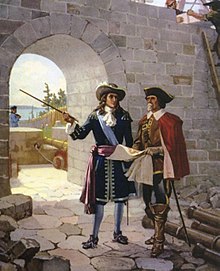
La Salle undertook several other smaller unknown expeditions between 1671 and 1673. On July 12, 1673, the Governor of New France,Louis de Buade de Frontenac,arrived at the mouth of theCataraqui Riverto meet with leaders of the Five Nations of the Iroquois to encourage them to trade with the French. While the groups met and exchanged gifts, Frontenac's men, led by La Salle, hastily constructed a rough wooden palisade on a point of land by a shallow, sheltered bay. Originally the fort was named Fort Cataraqui but was later renamedFort Frontenacby La Salle in honor of his patron. The purpose of Fort Frontenac was to control the lucrative fur trade in the Great Lakes Basin to the west. The fort was also meant to be a bulwark against the English and Dutch, who were competing with the French for control of the fur trade.[20]La Salle was left in command of the fort in 1673.
Thanks to his powerful protector, the discoverer managed, during a voyage to France in 1674–75, to secure for himself the grant of Fort Cataraqui and acquiredletters of nobilityfor himself and his descendants.[4]With Frontenac's support, he received not only afur tradeconcession, with permission to establish frontier forts, but also atitle of nobility.He returned and rebuilt Frontenac in stone. AnOntario Heritage Trustplaque describes La Salle at Cataraqui as "[a] major figure in the expansion of the French fur trade into the Lake Ontario region. Using the fort as a base, he undertook expeditions to the west and southwest in the interest of developing a vast fur-trading empire."[21]
This articleis missing informationabout La Salle's 2nd visit to France in 1677 to finagle the King for a charter to explore the Mississippi, and recruit mercenaries for the expedition.(June 2023) |
Great Lakes forts
After leaving Lower Canada in September 1678, La Salle and his lieutenantHenri de Tontitravelled toFort Frontenac(now inKingston, Ontario) and then to Niagara where, in December 1678, they were the first Europeans to viewNiagara Falls;they builtFort Contiat the mouth of the Niagara River.[22][23]
There they loaded supplies into smaller boats (canoesorbateaux), so they could continue up the shallow and swiftly flowing lowerNiagara Riverto what is now the location ofLewiston, New York.[24]
There the Iroquois had a well-establishedportageroute which bypassed the rapids and thecataractlater known asNiagara Falls.
The first ship built by La Salle, called theFrontenac,a 10-ton single-decked brigantine or barque, was lost in Lake Ontario, on January 8, 1679. Afterward, La Salle builtLe Griffon,a seven-cannon, 45-tonbarque,[16]on the upper Niagara River at or nearCayuga Creek.She was launched on August 7, 1679. La Salle sailed inLe GriffonupLake ErietoLake Huron,then up Huron toMichilimackinacand on to present-dayGreen Bay, Wisconsin.Le Griffonleft for Niagara with a load of furs, but was never seen again.[16]
La Salle continued with his men in canoes down the western shore ofLake Michigan,rounding the southern end to the mouth of the Miami River (nowSt. Joseph River), where they built a stockade in November, 1679. They called itFort Miami(now known asSt. Joseph, Michigan). There they waited for Tonti and his party, who had crossed the Lower Michigan peninsula on foot.
On December 3, 1679, with a group of 40, La Salle andHenri de Tontiheaded south from Fort Miami. They canoed up the St. Joseph and followed it to a portage at present-daySouth Bend, Indiana.They crossed to theKankakee Riverand followed it to theIllinois River.In January 1680, they reached an area that is near the current city ofPeoria, Illinois.In order to help the localPeoria tribedefend themselves against theIroquois,La Salle and his group built a stockade and named itFort Crèvecoeur.[25]
In March 1680, La Salle set off on foot for Fort Frontenac for supplies. A month after his departure, the soldiers at Ft. Crevecoeur, led byMartin Chartier,mutinied,destroyed the fort, and exiled Tonti, whom he had left in charge.[26]
Mississippi expedition

The group later travelled along the Illinois River and arrived at the Mississippi River in February 1682; they built canoes there. The exploration reached an area that is nowMemphis, Tennessee,where La Salle built a small fort, namedFort Prudhomme.[27]
In April 1682, the expedition reached the Gulf of Mexico. There, La Salle named the Mississippi basinLa Louisiane[11]in honor ofLouis XIVand claimed it for France.[28][29]
During 1682–83, La Salle, with Henry de Tonti, establishedFort Saint-Louisof Illinois atStarved Rockon the Illinois River to protect and hold the region for France.[30]La Salle then returned to Montreal and later, to France.[31]
Texas expedition and death
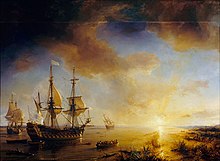
On July 24, 1684,[11]he departed France and returned to America with a large expedition designed to establish aFrench colonyon theGulf of Mexico,at the mouth of the Mississippi River. They had four ships and 300 colonists. The expedition was plagued bypirates,Natives defending their land, and poor navigation. One ship was lost to pirates in theWest Indies,a second sank in the inlets ofMatagorda Bay.TheLa Bellemade landfall in Feb. 1685.
They founded asettlement,near the bay which they called the Bay of Saint Louis, onGarcitas Creekin the vicinity of present-dayVictoria, Texas.La Salle led a group eastward on foot on three occasions to try to locate the mouth of the Mississippi. In the meantime, the flagshipLa Belle,the only remaining ship, ran aground and sank into the mud, stranding the colony on the Texas coast.[32]
Some of his menmutinied,near the site of present-dayNavasota, Texas.[g]
On March 19, 1687, La Salle was slain by Pierre Duhaut during an ambush while talking to Duhaut's decoy,Jean L'Archevêque.[34]They were "six leagues" from the westernmost village of theHasinai(Tejas) Indians.[11]One source states that Duhaut was a "disenchanted follower".[35]Duhaut was shot and killed by James Hiems to avenge La Salle. Over the following week, others were killed; confusion followed as to who killed whom.[36]
The colony lasted only until 1688, whenKarankawa-speaking Natives killed the 20 remaining adults and took five children as captives. Tonti sent a search mission in 1689 when he learned of the colonizers' fate, but the expedition ran out of supplies in northern Texas and failed to reach the site.[37]
It is now known that there were 15 survivors of the original 180 colonists at the fort, most of whom had accompanied La Salle on his final eastward trek to locate the mouth of the Colbert (Mississippi) River and escaped the massacre: 5 children at the settlement kidnapped by Native Americans and later rescued by the Spanish, and 10 other adults, who lived for a while among the Native Americans and were later captured and released by the Spanish; six found their way to Canada and eventually returned to France. Three others were refused passage by the Spanish; an Italian was imprisoned. For as long as 30 years after the demise of the colony, there were specious accounts of survivors still living among the Native Americans in Texas.
Personal life
La Salle never married,[38]but has been linked toMadeleine de Roybon d'Allonne,an early colonizer ofNew France.[39]
Legacy

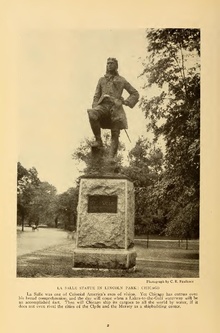

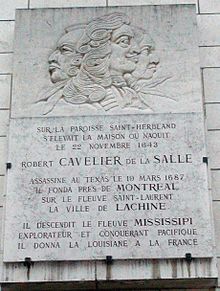
In addition to the forts, which also served as authorized agencies for the extensive fur trade, La Salle's visits to Illinois and other Natives cemented the French policy of alliance with Natives in the common causes of containing both Iroquois influence and Anglo-American colonization. He also gave the nameLouisiana (La Louisiane)to the interior North American territory he claimed for France, which lives on in thename of a U.S. state.
TheEncyclopædia Britannicaprovides this summary of La Salle's achievements: "His claim of Louisiana for France, though but a vain boast at the time, pointed the way to the French colonial empire that was eventually built by other men".[40]
Pierre Bertonwrote, "no other man had crammed so much adventure, so much excitement, so many triumphs, and so many heartbreaks into a single career. Though he died at the hands of some of his quarrelling followers in the mud of reeds of the Gulf of Mexico lowlands, he was essentially a man of the lakes, of Ontario and Erie, Huron and Michigan...."[41]
A sculpture of de La Salle is located on the south facade of the Knute Rockne Memorial on the campus of theUniversity of Notre Dame.[42]There is also astatue of himinChicago'sLincoln Park.
Archaeology
In 1995, La Salle's primary shipLa Bellewas discovered in the muck ofMatagorda Bay.It has been the subject of archeological research.[43][44]A search of the wreck and surrounding area during 1996 to 1997 yielded numerous artifacts from the 17th century.[45]Through an international treaty, the artifacts excavated from La Belle are owned by France[46]and held in trust by the Texas Historical Commission. The collection is held by theCorpus ChristiMuseum of Science and History. Artifacts fromLa Belleare shown at nine museums across Texas.
The wreckage of his shipL'Aimablehas yet to be located. In 1998, The National Underwater and Marine Agency claimed that it had found the wreck in Matagorda Bay but the Texas Historical Commission stated that the wreck was much more recent.[47]
The possible remains ofLe Griffonwere found in 1898 by lighthouse keeper Albert Cullis, on a beach on the western edge ofManitoulin Islandin northern Lake Huron. Results of testing some of the artifacts were disputed. Many of the recovered artifacts were lost and the wreck was washed away in 1942.[48][49]A possible shipwreck ofLe GriffonnearPoverty Islandat the entrance toGreen Bayin northern Lake Michigan was located by Steve Libert of the Great Lakes Exploration Group in 2001. The organization prevailed in a lawsuit against the state of Michigan over ownership of artifacts in 2012, and in 2013 was issued a permit to excavate the wreck. Only one artifact, a wood pole, was recovered, and it is indeterminate whether it was from a shipwreck. In 2019, theDiscovery Channelfeatured the story of the ship; divers who were involved in the investigation were convinced thatLe Griffonsank in theMississagi Strait.[50]
Historians debated the site of La Salle's "Fort St Louis" colony, which had been said to be nearLavaca Bayat Garcitas Creek, and was a significant part of the history ofFrench colonization of Texas.A June 1996 dig at the site that was believed to be the correct location revealed eight French cannon. This led archeologists to excavate the Keeran Ranch site in the area, during 1996–2002; they concluded that the SpanishPresidio La Bahíafort "was built on the La Salle settlement". Some 10 percent of the artifacts recovered are believed to have originated in France.[51]
Place names
Many places, streets, parks, buildings and other things were named in La Salle's honor:
Counties and towns
- LaSalle,inEssex County, Ontario,south ofWindsoron theDetroit River
- LaSalle, Quebecis a borough of the city ofMontreal,Quebec,Canada.
- LaSalle County, Illinois,the city ofLaSalleand theLaSalle Speedwaywithin it.
- LaSalle Parish, Louisiana
- La Salle County, Texas
- La Salle, Minnesota
Parks and streets
- TheLaSalle Expressway,a roadway throughNiagara Falls, New Yorkand its outer suburbs.
- LaSalle Street,a north–south thoroughfare inChicago,leads directly to the Board of Trade, and is the center of Chicago's financial district.
- TheLa Salle Causeway,connecting Kingston, Ontario to neighbouringBarriefield, Ontario.
- Jardin Cavelier de La Sallein the6ème arrondissementinParis
- La Salle Avenue, a downtown street inMinneapolis,Minnesota.
- Avenue La Salle, located inShawinigan,Quebec,Canada.
- La Salle Street inNavasota, Texas.It also contains a statue given by the local Robert Raines Chapter of the National Society Daughters of the American Revolution and the Texas Society Daughters of the American Revolution.
- Lasalle Road, an east–west road to the south ofSarnia,Ontario,Canada.
- LaSalle Avenue, a thoroughfare inSouth Bend, Indiana,which traverses the downtown area and carries a portion ofU.S. Route 20 Business.
- LaSalle Boulevard and Cavelier Road inMarquette Heights, Illinois,near Fort Crèvecoeur
- La Salle Avenue inWaco, Texas.
- La Salles Landing Park onIrondequoit Creekin Penfield, NY
- La Salle Park inBurlington, Ontario
- Robert LaSalle County Park,Door County, Wisconsin.
Buildings and other
- LaSalleautomobilebrand
- LaSalle-Peru Township High Schoolin LaSalle, Illinois has the mascot of the Cavaliers (Cavs) and Lady Cavaliers (Lady Cavs).
- La Salle Hotel,Chicago[52]
- LaSalle Hotelin downtownBryan, Texas
- École secondaire publique De La SalleinOttawa, Ontario
- La Salle Secondary School inKingston, Ontario
- De La Salle High SchoolinNew Orleans,Louisiana
Notes
- ^The Order prohibited a man taking final vows before the age of twenty-five. He was still considered a part of the Order as he was later barred to his inheritance.[5]
- ^This was apparently from theFrenchla Chine,forChina.The reference is unclear, but may refer to his intent to find a route to the orient.[8]
- ^For this, there is the detailed record of the journey of Casson and Galinee whom La Salle accompanied,[12]from which all historians take their accounts.
- ^What is now called the Gulf of California.[13]
- ^According to Parkman, it may have been caused by the sight of three rattlesnakes on a rock he was ascending.[15]
- ^It is purported by some that he journeyed via a stream passing six or seven leagues south of lake Erie, which was a tributary of the Ohio, to that river, thence downstream so far as the Falls of the Ohio below the site of the modern city of Louisville, where his crew abandoned him, and he returned to Canada on his own.[18]
- ^There is some disagreement about accepting Navasota as the site of La Salle's death.HistorianRobert Weddle, for example, believes that his travel distances were miscalculated, and that he was murdered just east of theTrinity River.[33]
Citations
- ^"René-Robert Cavelier, sieur de La Salle".Britannica.March 30, 2021.RetrievedMarch 21,2021.
- ^"René-Robert Cavelier, Sieur de La Salle, 1643–1687".Biography.March 30, 2021.RetrievedMarch 21,2021.
- ^Parkman, Francis(1869). "Chapter 1: Cavelier De La Salle".The Discovery of the Great West.France and England in North America. Vol. 3. Boston: Little, Brown and Company. p. 1.
- ^abcDupré, Céline (1979) [1966]."Cavelier De La Salle, René-Robert".In Brown, George Williams (ed.).Dictionary of Canadian Biography.Vol. I (1000–1700) (online ed.).University of Toronto Press.
- ^Parkman (1869),p. 2, note 1
- ^Parkman (1869),p. 4
- ^Parkman (1869),pp. 6–8
- ^"René-Robert Cavelier de La Salle 1670–1687", Musée Canadien de l'Histoire
- ^Parkman (1869), p. 8
- ^Gale, Neil. "Henri de Tonti and his Connection with what would become Illinois. (1650–1704)",Digital Research Library of Illinois History Journal,January 8, 2018
- ^abcdWeddle, Robert S. (October 30, 2011).La Salle's Texas Settlement.Texas State Historical Association.RetrievedNovember 4,2015.
{{cite encyclopedia}}:|work=ignored (help) - ^The Voyage of Dollier de Casson & Galinee 1669–1670, by Galinee
- ^"Names for the Gulf of California"(PDF).rickbrusca.RetrievedAugust 12,2023.
- ^Parkman (1869),pp. 7–9
- ^Parkman (1869), p. 10
- ^abcKeiley, Jarvis. "René-Robert-Cavelier, Sieur de La Salle." The Catholic EncyclopediaVol. 9. New York: Robert Appleton Company, 1910. 20 February 2023
 This article incorporates text from this source, which is in thepublic domain.
This article incorporates text from this source, which is in thepublic domain.
- ^abParkman (1869), p. 19
- ^Pierre Margry,Decouvertes et Etablissements des Francois dans l'Ouest et dans le Sud de l'Amerique Setptenrionale, 1614–1754, Paris, 1876–1888
- ^Krauskauf p. 147
- ^"The History of Fort Frontenac".The Cataraqui Archaeological Research Foundation.Archived fromthe originalon August 15, 2014.RetrievedNovember 4,2015.
- ^"Plaque information: René-Robert Cavelier de La Salle at Cataracoui".Ontario Heritage Trust.Archived fromthe originalon September 24, 2015.RetrievedNovember 4,2015.
- ^"The Explorers, Louis Hennepin 1678–1680".RetrievedMarch 21,2021.
- ^"Early Canada".RetrievedMarch 21,2021.
- ^"Relation of the Discoveries and Voyages of Cavelier de La Salle from 1679 to 1681: The Official Narrative".RetrievedMarch 21,2021.
- ^"Fort Crèvecoeur, a 1680 French-Peoria Agreement".December 7, 2018.RetrievedMarch 21,2021.
- ^"Fort Crevecoeur – built in 1680".Fort Crevecoeur Park and Campground.April 1, 2015. Archived fromthe originalon November 12, 2015.
- ^"La Salle, René-Robert Cavelier de".Encyclopedia.March 30, 2021.RetrievedMarch 21,2021.
- ^"René-Robert Cavelier, Sieur de La Salle, 1643–1687".Biography.March 30, 2021.RetrievedMarch 21,2021.
- ^"The Explorers, René-Robert Cavelier de La Salle 1670–1687".History Museum.March 30, 2021.RetrievedMarch 21,2021.
I, René-Robert Cavelier de La Salle, by virtue of His Majesty's commission, which I hold in my hands, and which may be seen by all whom it may concern, have taken and do now take, in the name of His Majesty and of his successors to the crown, possession of the country of Louisiana...
- ^"Starved Rock, Illinois".Park History, NPS.March 30, 2021.RetrievedMarch 21,2021.
La Salle concentrated thousands of Indians as part of his ambitious plan to protect and exploit the vast new territory that he claimed for France.
- ^"Sieur de La Salle".Encyclopedia.March 30, 2021.RetrievedMarch 21,2021.
- ^"Rene Robert Cavelier, Sieur de la Salle", Calhoun County Museum
- ^Joutel, Foster & Warren (1998),p. 35
- ^Joutel, Foster & Warren (1998),p. 199
- ^"La Salle Expedition".Texas State Historical Association.RetrievedMarch 30,2021.
- ^"Liotot".Texas Historical Commission.RetrievedMarch 30,2021.
- ^Joutel, Foster & Warren (1998),p. 13
- ^Margry, Pierre.Découvertes et établissement des Français dans l'ouest et dans le sud de l'Amérique Septentrionale[Discoveries and French Settlement in the West and South of North America] (in French). Vol. 2. p. 88.
- ^Dupré, Céline (1979) [1969]."Roybon D'Allonne, Madeleine De".In Hayne, David (ed.).Dictionary of Canadian Biography.Vol. II (1701–1740) (online ed.).University of Toronto Press.
- ^"René-Robert Cavelier, sieur de La Salle".RetrievedMarch 30,2021.
- ^Pierre Berton(1996).The Great Lakes.p. 29.
- ^Lindquist, Sherry C. M. (March 2012)."Memorializing Knute Rockne at the University of Notre Dame: Collegiate Gothic Architecture and Institutional Identity".Winterthur Portfolio.46(1): 1–24.doi:10.1086/665045.ISSN0084-0416.S2CID146612474.
- ^"La Salle Archeology Projects".Texas Historical Commission.August 4, 2015.
- ^Parker, Dan (1996)."Raising The Belle – La Salle's last ship".Corpus Christi Caller-Times.Archived fromthe originalon March 16, 2005.
- ^"La Salle Archeology Projects La Belle and Fort St. Louis Excavations".Texas Historical Commission.RetrievedMarch 30,2021.
- ^"La Belle artifacts tell quite a story".Artifacts.RetrievedMarch 30,2021.
- ^"Small Arms and Munitions from a Texas Coastal Shipwreck".Researchgate.RetrievedMarch 30,2021.
Subsequent investigation of the site by the Texas Historical Commission discovered the vessel likely dated to the late 18th or early 19th centuries.
- ^The Wreck of the Griffon, Kohl and Forsberg, 2015. Seawolf Publishing Co.
- ^Ashcroft, Ben."Le Griffon: The Great Lakes' greatest mystery".The Detroit Free Press.USA Today.
- ^"Manitoulin's most famous maritime mystery: Still unfathomable after all these years".The Expositor.July 17, 2019.RetrievedMarch 30,2021.
the most thorough work yet on the unsolved centuries-old maritime mystery, generously illustrated with historical and modern photos and maps.
- ^"La Salle's Texas Settlement".Texas State Historical Association.RetrievedMarch 30,2021.
- ^Randall, Frank Alfred; Randall, John D. (1999).History of the Development of Building Construction in Chicago.University of Illinois Press. p. 271.ISBN0-252-02416-8.
References
 Texts on Wikisource:
Texts on Wikisource:
- Shea, John Gilmary(1882). "La Salle, Robert Cavelier, Sieur de".Encyclopædia Britannica.Vol. XIV (9th ed.).
- Parkman, Francis(1892). "La Salle, Robert Cavelier, Sieur de".Appletons' Cyclopædia of American Biography.
- Whinery, Charles Crawford (1911). "La Salle, René Robert Cavelier, Sieur de".Encyclopædia Britannica(11th ed.).
- Keiley, Jarvis (1913). "René-Robert-Cavelier, Sieur de La Salle".Catholic Encyclopedia.
- Joutel, Henri; Foster, William C.; Warren, Johanna S. (1998).The La Salle Expedition to Texas: The Journal of Henri Joutel, 1684–1687.Austin, TX: Texas State Historical Association.ISBN0-87611-165-7.Archived fromthe originalon May 11, 2019.RetrievedOctober 22,2016.[ISBN missing]
Further reading
- Justin Winsor (1884).Narrative and critical history of Americavol. IV, pp. 200–246. Includes several maps drawn by La Salle.
External links
- The journeys of Rene Robert Cavelier, sieur de La Salle.Volume 1,Volume 2(hosted by thePortal to Texas History)
- The Handbook of Texas Online:Renê Robert Cavelier Sieur de La Salle
- Detailed Account ofLa Sallein Texas
- La Salle's Map of TexasfromA pictorial history of Texas, from the earliest visits of European adventurers, to A.D. 1879,hosted by thePortal to Texas History.
- Texas Beyond History
- 1643 births
- 1687 deaths
- Explorers of Canada
- Explorers of the United States
- French people murdered abroad
- People of New France
- People of Louisiana (New France)
- French nobility
- French colonization of Texas
- Persons of National Historic Significance (Canada)
- Businesspeople from Rouen
- Lycée Pierre-Corneille alumni
- 1660s in New France
- 1670s in New France
- 1680s in New France
- 1660s in Canada
- 1670s in Canada
- 1680s in Texas
- French explorers of North America
- 17th-century explorers
- 17th-century French people
